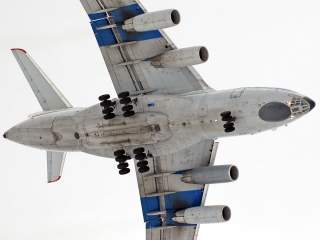Russia's Military Has a Problem: Too Many Paratroopers, Not Enough Transport Planes
So how does Moscow fix it?
Russia has the largest paratrooper force in the world. Well-trained and equipped with air-droppable armored vehicles for mobility and firepower on the ground, the Vozdushno-Desantnye Voyska (“airborne forces,” or VDV) are the Kremlin’s expeditionary assault troops, leading the invasions of Afghanistan in 1979 and Crimea in 2014.
But are there too many Russian paratroopers and not enough transport planes to carry them all? That idea has been mooted by a Russian commentator, who suggests the Russian airborne forces—a separate branch of the Russian military—are too politically powerful to be trimmed. Interestingly, those comments appeared in the pro-government newspaper Izvestia.
“At the present time, two airborne and two air assault divisions, four air assault brigades, a separate Spetsnaz [commando] brigade, and a number of support and training units are in the Russian Airborne Troops’ composition,” writes Ilya Kramnik, according to a translation in the September issue of OE Watch, the magazine of the U.S. Army’s Foreign Military Studies Office.
Yet the Russian Air Force currently has about 120 Il-76 transport aircraft, Russia's equivalent of the U.S. Air Force’s C-17 transport. “Let’s recall that 45 aircraft were involved in the exercises that recently occurred, which were enough for the paradrop of less than a VDV regiment, including two battalions with armored vehicles,” Kramnik writes. “So, the entire available fleet of Il-76 military transport aircraft is enough to paradrop less than two regiments with a standard set of weapons and military equipment using one sortie.”
In other words, despite maintaining a multi-division airborne force, Russia only has lift capacity to drop less than a division at a time. This problem was even recognized back in the days of the Soviet Union.
“It is impossible to change the situation that has developed with the shortage of aircraft for the use of the VDV based upon its primary designation in the foreseeable future—this would require a multi-fold increase of the strength of military transport aviation,” writes Kramnik. He adds that “this raises definite questions with regard to the effectiveness of the expenditure of budget resources, while taking into account the high cost of specialized parachute equipment and the jump training of personnel.”
Of course, transport planes can fly more than one sortie. But as the Allies discovered during the failed Operation Market Garden airborne landings in September 1944, airdropping troops in multiple waves is dangerous. It means fewer troops on the ground in the first wave, when the element of surprise—the airborne’s supreme asset—is greatest and lightly armed paratroopers can most easily secure their objectives.
All of which raises an obvious question: why doesn’t Russia just trim the number of paratroopers to match the number of transport aircraft? The U.S. only has about two hundred C-17 aircraft, but that's enough for its one airborne division, the 82nd (the 101st Airborne is now a helicopter-borne air assault unit), plus assorted Ranger and Special Forces units. Indeed, airborne forces have conducted relatively few combat drops since their glory days of World War II. Nowadays, they are more likely to be used as elite light infantry.
Recommended: What Will the Sixth-Generation Jet Fighter Look Like?
Recommended: Imagine a U.S. Air Force That Never Built the B-52 Bomber
Recommended: Russia's Next Big Military Sale - To Mexico?
Recommended: Would China Really Invade Taiwan?
The answer is politics. “Taking into account the Armed Forces structure that has developed and the VDV’s political weight in their composition, we need to realize that it is unlikely that anyone will undertake such a radical reform in the foreseeable future,” Kramnik concludes.
To be fair, it’s no different in the United States, when suggestions to close military bases or forego purchases of lucrative weapons draw fierce opposition from legislators and local communities.
Under Communism or capitalism, politics remains the most formidable foe of common sense.
Michael Peck is a contributing writer for the National Interest. He can be found on Twitter and Facebook.

